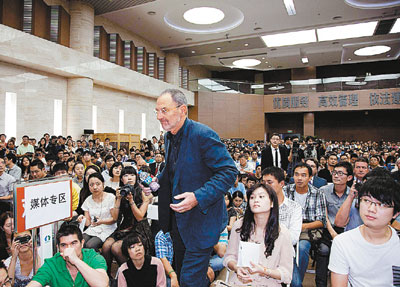|

Cao Zhen caozhen0806@126.com
WHEN the 324.8m-high Diwang Mansion was completed in Shenzhen’s Luohu District in 1996, it was the tallest building in Asia, and continued to be the city’s tallest for 15 years, before it was displaced by the 441.8m-high KK100 Tower in the same neighborhood last year.
Today, at least a dozen taller buildings than the KK100 are nearing completion around the world. Several areas in Chinese or Asian metropolises, which until a few years ago had “affordable housing” settlements for lower-income groups, have undergone a sea change. They are now mainly characterized by skyscrapers.
Tall buildings, once almost exclusively a product of the United States, are spreading across the globe at an ever-increasing rate. Today’s highest skyscraper — the 828m-high Burj Khalifa in Dubai — is set to be overtaken by the 1,000-meter-high Kingdom Tower in Jeddah, Saudi Arabia, when it’s completed in 2018. Developing countries are eclipsing the West in skyscrapers, fueled by faster economic growth and a desire to show off the wealth and vitality of cities.
On Saturday, a forum titled “Design Practice of Skyscrapers in the New Century” was held by local developer Hanking Group. The company will build the 320m-high Hanking Center near Shenzhen High-Tech Industrial Park and is inviting global architects to design it.
At the forum, seven top-notch architects — Meng Yan from Shenzhen Urbanus, Stefan Krummeck (KK100), American Thom Mayne (Phare Tower), American Benjamin Ward (Shanghai Tower), American Walter Geiger (Excellence Qingdao), American Adrian Smith (Burj Khalifa) and German Ole Scheeren (CCTV Tower) — talked about a wide range of issues on skyscrapers.
The issue of density and how best to live sustainably in booming urban centers was one of the key focal points of the forum, and the architects did not hold back on their opinions and suggestions on the need to tackle space issues.
One key solution is upward planning. A concept, described by the architects as a “vertical city,” would consist of a tall building that contained both infrastructure and precinct development including housing, offices and both commercial and public spaces.
Thom Mayne, who won the Pritzker Prize in 2005, said the “vertical city” concept in skyscraper design would help stimulate human interaction, which means the complex would be like a community, where people can have offices, schools, hospitals, landscapes and public spaces.
“Most people judge an architectural work on its style. But the look is the last thing I think about when I’m designing,” said Mayne. “Enhancing people’s lives, promoting the building’s value and contributing to the city’s environment are all more important,” Mayne added.
Ole Scheeren, whose latest project is Angkasa-Raya, a 268m-high tower opposite Kuala Lumpur’s famous Petronas Twin Towers, said that the building has a sophisticated passive shading system which will substantially reduce the building’s energy consumption. But the most important aspect is how to integrate the building into the urban context by continuing the streetscape inside its ground levels with a mix of people, shops and cars.
Scheeren, who travels a lot and gets involved with different local cultures, said the building reflects the diverse and multicultural character of Kuala Lumpur.
Skyscrapers have become synonymous with the greatest excesses of energy expenditure. Though there are definite energy advantages to having tall buildings, both in creating more sustainable patterns of life through higher density and also through the potential for greater renewable energy generation at height, most existing tall buildings are energy-profligate.
“If we want to continue making super tall buildings and we want them to be sustainable, they will need to be able to produce power. You can design them to reduce energy usage, but that’s not enough. You have to put power-generating technology into these towers to drive down carbon emissions,” said Adrian Smith, whose credits include Jin Mao Tower in Shanghai, Wuhan Greenland Center and Kingdom Tower in Jeddah.
Smith’s unique design approach emphasizes sensitivity to the physical environment. He considers each project holistically, taking into consideration wide orientation, climate and geography, cultural and social influences to create highly sustainable projects that achieve contextualism within the global environment.
As one of the world’s foremost experts on skyscrapers, he recently collaborated with Gordon Gill to design the world’s first net zero-energy skyscraper, Pearl River Tower to be built in Guangzhou. The design harvests the natural forces of wind, sun, the geothermal mass and continues Smith’s tradition of integrating energy-efficient systems into his designs.
There is also an urbanistic argument against the proliferation of skyscrapers. The architects agreed that historically, most have been designed as either for corporate usage, or to create an iconic cityscape. Both lead to stand-alone architecture — a one-size-fits-all skyscraper which rejects, in some places, thousands of years of vernacular traditions.
Hong Kong-based Stephan Krummeck defended skyscrapers as tools for urban development. “We believe that this new high-density urban model is in its infancy and has a great future ahead of it,” he said. “However, we are in complete agreement that towers that are built solely as status symbols, which lack connectivity, which are not integrated with their surroundings, are indeed destined for failure. The urban context must include both buildings and the space between them.”
Meng Yan, who designed a dozen local venues, such as Excellence Times Square Phase II, agreed that height is not the only important aspect of a building and regulating the city space to enhance people’s life is the most important thing. “Skyscrapers are not free standing monuments, but are products of sophisticated urban mechanisms. In some ways, skyscrapers can redefine urban conditions in the future,” said Meng.
|

